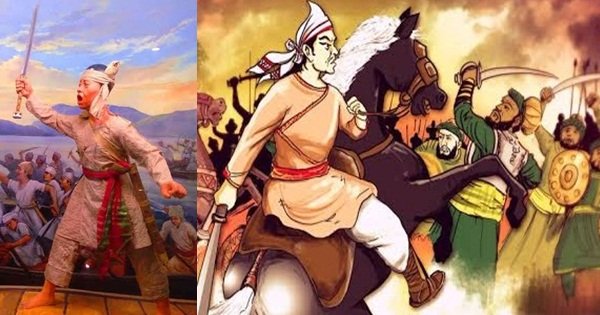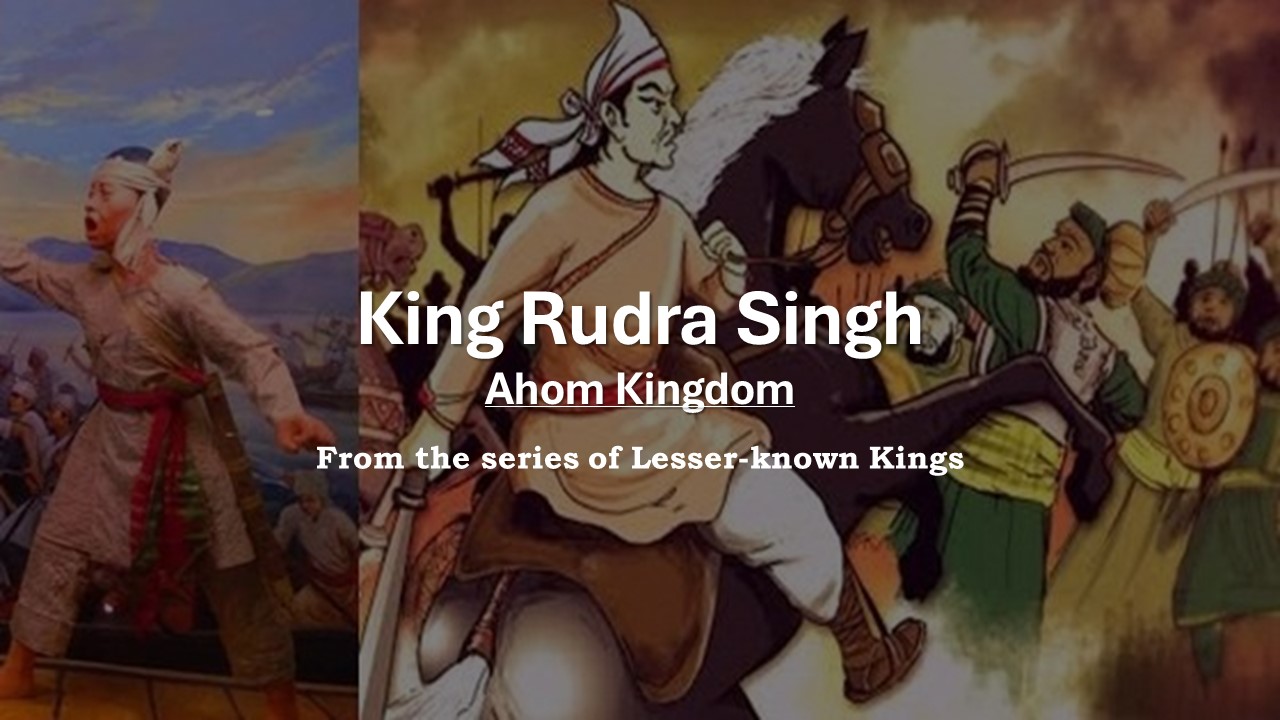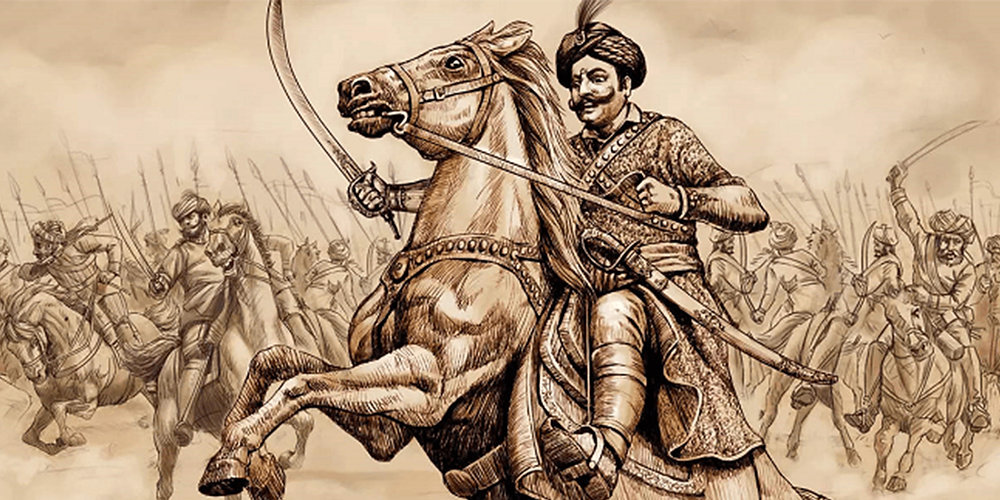History is full with examples of kings whose greatness was defined not by their formal education but by their vision, actions, and commitment to their people and culture. One such figure is King Rudra Singha (Sukhrungphaa) of the Ahom dynasty in Assam. Despite being “illiterate” (possibly dyslexic), Rudra Singha left an unparalleled legacy in governance, culture, and spirituality. His reign marked a golden era for Assam, rooted deeply in the values of Sanatan Dharma.

This blog explores the life, challenges, and contributions of Rudra Singha, emphasizing his enduring devotion to dharma and the cultural renaissance he sparked in Assam.
Early Life and Challenges
Rudra Singha was born into the illustrious Ahom dynasty, which had ruled Assam since the 13th century. Ascending the throne in 1696, he faced a unique challenge—he was unable to read or write, likely due to dyslexia, a condition not understood in those times. Despite this, he displayed remarkable intellect, relying on oral communication, practical wisdom, and the support of learned advisors.
His inability to engage with texts never deterred his determination to serve his people and promote dharma. Instead, it fueled his efforts to leave behind a legacy that would resonate through generations.

Rudra Singha’s Contributions to Sanatan Dharma
King Rudra Singha’s reign is remembered as a period of spiritual renaissance in Assam. Despite his limitations, he undertook several initiatives to uphold and propagate the values of Sanatan Dharma, leaving a lasting impact on Assamese culture and society.
Promotion of Vaishnavism
Rudra Singha was a devout follower of Vaishnavism, a tradition of Sanatan Dharma that emphasizes devotion to Lord Vishnu and his avatars.
- Support for Vaishnavite Monasteries: He provided royal patronage to the Sattras (Vaishnavite monasteries), which became centers of spiritual learning, art, and culture.
- Encouraging Bhakti Literature: His reign witnessed a flourishing of Bhakti literature and performances, promoting the teachings of saints like Srimanta Sankardev and Madhavdev.
Construction of Temples and Religious Sites
Rudra Singha’s devotion to Sanatan Dharma was reflected in his efforts to build and renovate several temples and other spiritual monuments.
- Kamakhya Temple Renovation: Although earlier Ahom kings had contributed to the Kamakhya Temple in Guwahati, Rudra Singha continued this tradition, ensuring the temple remained a central site for Shakti worship. The Kamakhya Temple remains one of the most revered shrines of Goddess Durga in India.
- New Temple Constructions: He commissioned the construction of various temples dedicated to Lord Vishnu and Shiva across Assam, fostering spiritual connectivity among his subjects.
Integration of Indigenous and Vedic Traditions
As a king of Tai-Ahom descent, Rudra Singha skillfully integrated the indigenous faith of the Ahoms with the broader traditions of Sanatan Dharma.
- He introduced Vedic rituals at court while respecting and preserving local customs.
- By merging these traditions, he created a unique spiritual and cultural identity for Assam that celebrated diversity within the framework of dharma.
Festivals and Pilgrimages
Rudra Singha actively encouraged the celebration of Hindu festivals, making them integral to Assamese life.
- He promoted large-scale observances of festivals like Durga Puja, Janmashtami, and Rath Yatra, which brought people together and reinforced the values of devotion and unity.
- He organized pilgrimages to sacred sites across India, encouraging spiritual growth among his people.
Legacy of a Great King
Despite his illiteracy, Rudra Singha’s reign (1696–1714) is considered one of the most culturally vibrant and spiritually enriching periods in Assam’s history. His contributions to Sanatan Dharma and Assamese culture continue to inspire generations.
Architectural Marvels
Apart from his religious contributions, Rudra Singha left behind architectural wonders that symbolize the blend of spiritual and cultural heritage:
- Rang Ghar: An amphitheater used for cultural and religious events.
- Talatal Ghar: A seven-story palace that reflects the ingenuity of Ahom architecture.
Cultural Unity
By promoting Vaishnavism and other Hindu traditions, Rudra Singha united the diverse communities of Assam under a shared cultural and spiritual framework. His policies fostered inclusivity and harmony, laying the groundwork for a strong and unified kingdom.
Inspiration for Future Generations
Rudra Singha’s life is a testament to the power of perseverance and the impact of spiritual leadership. Despite his inability to read or write, he demonstrated that dedication to dharma and the welfare of one’s people defines true greatness.

The Suffering of a Visionary King
Behind Rudra Singha’s achievements lay a life of quiet struggle. His inability to engage with written texts might have caused personal frustration, but he refused to let this define him. Instead, he relied on his advisors, oral traditions, and innate wisdom to govern effectively.
Tragically, Rudra Singha’s ambitious plans for expansion—particularly his dream of conquering Bengal—were cut short by his untimely death in 1714. Despite this, his reign remains a golden chapter in Assam’s history.
Lessons from Rudra Singha’s Life
1. Greatness Lies Beyond Formal Education: Rudra Singha’s life proves that personal limitations do not define a leader’s potential.
2. Preservation of Dharma: His devotion to Sanatan Dharma ensured that spiritual values were deeply embedded in Assamese culture.
3. Unity in Diversity: Rudra Singha’s integration of different traditions exemplifies the inclusive spirit of dharma.
Conclusion
King Rudra Singha’s legacy is a powerful reminder that true leadership is measured not by formal education but by vision, resilience, and a commitment to one’s people and culture. His contributions to Sanatan Dharma, Assamese heritage, and the spiritual unity of his kingdom make him one of the most remarkable figures in Indian history.
As we explore lesser-known kings in this series, Rudra Singha’s story stands out as an example of how even the greatest challenges can be overcome in the service of dharma and humanity.


